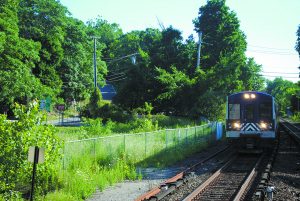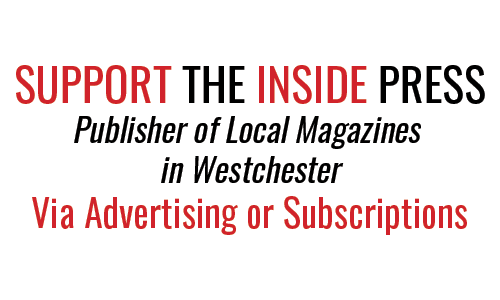
New Castle residents and officials. Photo by Andrew Vitelli
Dear Editor:
Those of us who are part of Chappaqua for Responsible Affordable Housing would like to respond to recent media reports regarding Conifer Realty’s proposed affordable housing project on Hunts Place in Chappaqua. In particular, we want to refute, in the strongest possible terms, the accusation of discrimination made in these reports by Conifer and their new attorney, Randall McLaughlin. These accusations are completely false and contradicted by the record and the facts. They are part of a new campaign to try to rescue Conifer’s poorly conceived and planned proposal by drawing HUD into the process under the guise of accusing community members who oppose the project of discriminatory intent.
In fact, we have opposed this particular site, which is a tiny parcel sandwiched between the Parkway off-ramp and the Metro-North train tracks, simply because it is a terrible location for affordable housing, is in direct opposition to Federal Monitor James Johnson’s criteria, and would result in the creation of discriminatory housing. There are vastly superior sites in our Town that are part of residential neighborhoods, and will create safe and dignified housing, to meet the goals of the Westchester County Housing Settlement. We strongly support the construction of affordable housing on these sites.
We are an informal group of New Castle residents, including architects, engineers, business people and others, who have joined together to advocate for socially responsible solutions to the need for affordable housing in the Town of New Castle. From the outset, we have made it clear that we support the creation of affordable housing in our community, and we embrace the goals of creating this housing, as clearly articulated by the Federal Monitor in the 2009 County Settlement with HUD to construct 750 units of “fair and affordable housing”, including that it be integrated into existing residential neighborhoods, and not inherently stigmatize or isolate residents as low income.
It is exactly on these points that we oppose the Hunts Place project. The site is a tiny, isolated, highly-contaminated strip of land, squeezed between the Parkway off-ramp, the Metro-North railroad tracks and a highway bridge. The proposed building, which is intended for families and children, would be crammed onto this tiny site with no room for open play space. This would represent the opposite of the goals and intents of affordable housing, because this location would inherently isolate and stigmatize our new neighbors. Building affordable housing on this site would in fact be an act of discrimination.
The media campaign by Conifer and Mr. McLaughlin to therefore characterize the opposition to the Hunts Place proposal as discriminatory is shameful, and simply does not comport with the facts. As long ago as 2007, the Town’s Planning Board, when considering a market-rate housing proposal on this site, labeled it as “unsuitable for residential use”, and in 2012, the Federal Monitor himself stated “the site has all the indicia of isolation” and “the stigma associated with isolation cannot be overcome.”
Further below, we address some of the inaccurate and misleading statements being made in the media. In considering these, readers should bear in mind the following:
Conifer Realty is a for-profit developer that stands to earn a $2 million development fee for this project, and the property owner stands to earn $1.3 million for a highly-contaminated property that was purchased in 2005 for $290,000, plus having taxpayers pay another $1.2 million to clean it up. They are highly motivated by purely financial reasons to push this project through, and are likely compensating Mr. McLaughlin very well for his efforts to force it through;
The project cost, per filings by Conifer, is an astronomical $15.2 million – or $542,000 per unit – making this the most expensive affordable housing project in the County by almost 40%;
Because the building program is too massive for this small site, eight State Building Code and Fire Code variances are required, all of which are life-safety issues. These variances can only be granted by a State Board of Review panel – the Town Building Inspector cannot issue a building permit unless these variances are granted. Having presented their case to the local Hudson Valley Board of Review, it appears that Conifer knows that at least some of the variances will be denied, so they have begun this campaign to claim discrimination to try to draw HUD into the process, while also attempting to use their influence to move the variance review to another Board, in order to obtain a favorable ruling.
In 2007, our Town Planning Board reviewed a market-rate multi-family housing proposal on this site, and advised our Town Board to reject the proposal – which it subsequently did – stating that the site is “not suitable for residential use” due to traffic issues, density, and the environmental issues of the abutting railroad & highway, and was particularly not conducive to occupancy by children.
Despite this knowledge, Conifer proposed this project on a site that did not comply with local zoning and land-use regulations, and proposed a building that did not comply with the State Building Code. As such, in deciding to pursue this project, as the developer, they accepted the risk that they may not achieve the approvals that they were seeking, and their investment in attempting to achieve the approvals was always at their risk. No one or entity could give them any guarantee that they would achieve all of the necessary approvals
The site does not comply with the Federal Monitor’s published and very specific Best Practices Criteria for Site Selection. These include site features that would be more heavily scrutinized: adjacent highways and railroads are barriers that isolate a site and cannot be mitigated; sites that inherently stigmatize and isolate residents as low income; sites that do not seamlessly integrate with an adjoining residential neighborhood; and sites that have obvious negative environmental impacts, such as excessive noise from a railroad, that cannot be successfully mitigated. In fact, the Monitor expressed his concerns about the site in two letters to Conifer, one on April 23, 2012 and again on July 17, 2012. The July 17 letter made these very points about this project: “This letter sets forth my concern that this project, as currently designed, will not further the goals of the consent decree and raises the risk of significant stigmatization and isolation of residents.” “This site has many of the indicia of isolation… Given these physical challenges, one could reasonably conclude that the obstacles to integration with the community, and the stigma associated with separation, cannot be overcome.” Curiously, with no noticeable change to the configuration of the building or the environmental issues of the location, the Monitor flip-flopped and later expressed his support for the project.
One of the available alternative sites is located along Washington Ave., near Town Hall. The property is owned by the Town, and was presented to the Town Board back in May 2012 by one of the architects in our group for consideration as an alternate site for affordable housing. Nothing was pursued on this site by that Town Board. The current Town Board is making the effort to pursue this site as an alternative. This site does have wetlands on the property, however these are not native wetlands, but altered wetlands. As the Town is aware, and as Conifer has itself done on Long Island, such wetlands can be replaced with offsite mitigation. While Mr. McLaughlin expresses opposition to this site due to his concern for the environmental impacts of developing on the wetlands, he apparently sees no problem with putting families & children on a highly-contaminated site between a Railroad and a Parkway, while also failing to disclose the fact that Conifer itself was recently lauded in Brookhaven for their work in creating off-site wetlands to replace altered wetlands on a site for new multi-family housing there.
Finally, we would like to point out some of the inaccurate and misleading statements made by Mr. McLaughlin in his attempt to paint those in the community who are opposed to the project as being motivated by discriminatory intent:
1. “The opponents claim that there are safety issues when each of these issues were adequately addressed during the prior Town Board review.”
Fact: the Town Board did not review the issues of the Building Code and Fire Code variances, specifically avoiding them as they understood that they would be the subject of a review by the State Board of Review. They did not review fire access to the building and rescue scenarios, did not review the fire risks of the building being constructed against the property lines, did not discuss the routes required for emergency vehicles to get to the site, and did not discuss the safety issues of the adjacent Parkway off-ramp.
2. “If this project were market-rate, there would not be this hue and cry.”
Fact: As stated above, in 2007, the Town Planning Board and Town Board rejected a market-rate housing proposal at this site, stating that the site was unsuitable for residential use, citing concerns for the negative environmental impacts, particularly on children. If it was not suitable for market-rate housing, it should certainly not be suitable for affordable housing.
3. “There are about 300 children in a gymnastics program right down the street & no one complains about that.”
Fact: The gymnastics program is a commercial use appropriately located in a commercial / industrial district, is located more than ¼ mile from this intersection, and children are brought to the site by vehicle. This cannot be compared to an inappropriate residential use located immediately at the intersection of a 55-mph Parkway off-ramp, next to the railroad tracks, jammed onto a tiny site, with no outdoor play area for children.
4. “These children will be stigmatized… because they don’t dress the right way, or they don’t have the right cars, and they live in that low-income project.”
Fact: This has never been the focus of our group. Like HUD and the Federal Monitor, we advocate for building affordable housing in safe and appealing locations, free from isolating and/or stigmatizing factors that would present unnecessary barriers to integration. Mr. McLaughlin is trying to denigrate the entire community by taking an edited statement out of context.
In summary, our opposition to the Conifer proposal is purely and simply a matter of opposing the construction of affordable housing on a terrible site that is unsuitable for residential use, and standing up to a developer that shows no concern for the quality of the housing that it is providing and whose sole interest is to earn its $2 million development fee. It is unacceptable to put our new neighbors, families and children, at risk on this site purely for the developer’s financial gain. There are other available sites in Town that are integrated into existing residential neighborhoods, and we should be using our precious resources to build housing that meets these goals.
Rejecting an affordable housing project clearly takes courage by local, County and State officials, and leaves them open to false accusations of discrimination, to which Conifer has now resorted and accurately predicted would catch the attention of the media. In this case, such accusations are completely contradicted by the record and the facts.
We hope that the ultimate rejection of this project will remind all involved in this process that the goal of the Settlement is to provide housing for real people, not just checking off a box for a particular community, and that the focus must always remain on the quality of life for the individuals, families and children who would live in this new housing.
Chappaqua for Responsible Affordable Housing
Bill Spade, Founding Member
